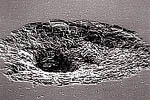 Exploring
Space, Page 4 of 6
Exploring
Space, Page 4 of 6
![]() cientists
estimate that monster meteorites, those above a mile in width, hit only
once every 300,000 years. A ten-mile-wide impactor, like the dino-killer,
is rarer still, striking the earth on the average of once every 100 million
to one billion years.
More
frequent are smaller objects, such as the 180-foot rock that exploded
over Tunguska, Siberia, in 1908, flattening trees for about 15 miles in
all directions. Objects of this size invade our atmosphere every few centuries
on average, causing extensive local damage. If they hit the ground, they
create large craters a mile or so in width. The most common meteors, however,
are created by dust particles that have an average size of about 0.2 millimeters.
Most of them never make it through the atmosphere intact. Instead, they
melt and burn high above the earth in spectacular displays commonly known
as shooting stars.
cientists
estimate that monster meteorites, those above a mile in width, hit only
once every 300,000 years. A ten-mile-wide impactor, like the dino-killer,
is rarer still, striking the earth on the average of once every 100 million
to one billion years.
More
frequent are smaller objects, such as the 180-foot rock that exploded
over Tunguska, Siberia, in 1908, flattening trees for about 15 miles in
all directions. Objects of this size invade our atmosphere every few centuries
on average, causing extensive local damage. If they hit the ground, they
create large craters a mile or so in width. The most common meteors, however,
are created by dust particles that have an average size of about 0.2 millimeters.
Most of them never make it through the atmosphere intact. Instead, they
melt and burn high above the earth in spectacular displays commonly known
as shooting stars.

|
|
|
An
impact crater on the window of the space shuttle
Challenger
,
possibly caused by a micro-meteoroid. Another possible explanation
is that the crater was formed by a speck of paint that had flaked
off another spacecraft. [
Click
for a
larger image.] Photo: NASA.
|
Meteorites that land on earth can provide researchers with valuable information. Scientists track down larger meteorites and impact sites, searching for clues about the birth of the solar system and the earth's geologic past. A popular hunting ground is Antarctica, where the dark objects are easy to spot against the icy white background.
By chemically analyzing
meteorites, scientists can determine their makeup, which is primarily
iron, nickel, and silicate rock. Determining the composition of a meteorite
can help us infer the composition of the earth's interior. Analysis also
reveals a meteorite's point of origin and its age. The oldest space rocks
are about 4.6 billion years old, leading scientists to conclude that that's
the age of the solar system as well.
|
|
|
|